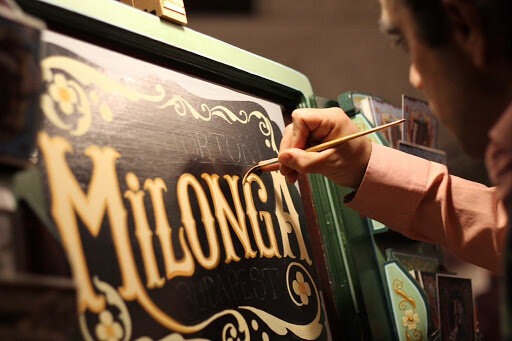
Culture
Art
Two most famous art forms:
The Tango.
Argentina created the Tango, one of the most well known dances around the world. This dance was created in the 1880s in the lower class areas of Buenos Aires and Montevideo.
It started outside the brothels and bars of ports as a form of entertainment. Originally it was banned by the church because it was considered the dance of the “immoral”, but in 1930 it was no longer banned. The tango then spread to the rest of the world, becoming an elegant and stylish dance often enjoyed by the upper class.
Fileteado.
Buenos Aires is also famous for a type of artistic drawing and lettering called Fileteado, which uses stylised lines lively colours and climbing plants. It is used to decorate all kinds of objects: trucks, buses, signs, taxis and more.
It originated in the wagon factories in the early 20th Century. After building the carriages, Italian immigrants began to paint them with lines and decorative drawings. Their playful drawing soon became an art form, which can now be seen all around the city.
Reasons these art forms came about.
For both art forms the reason they came about was for entertainment, enjoyment and to help businesses thrive. Tango dancers were hired to attract and entertain customers and outside Port cafes and business.
The Fileteado started out as a way to add colour and style to wagons and to the bland wagons of Buenos Aires. In the beginning, it was all about simple lines filling the wagon’s panels, or separating two colours on the side. Over time, more decorative pictures were added, until it became the Fileteado style we see today
Are the Tango and Fileteado for everyone?
Both of these well-known art forms originated in Buenos Aires where the streets were bustling and alive and there were many businesses exploring different ways to make money.
They also both originated in the lower-class areas where there was more of a need to think creatively to help businesses thrive. Immigrants were heavily involved and influenced the art forms, for example, the Tango has similarities to Spanish and African dances.
In terms of gender, the Tango has always been performed between a man and a woman, however the two had very reasons for dancing the tango. Woman often took up the Tango to gain confidence and to find a relationship, where-as men took up the tango to be flirty. Over time, the tango culture changed, both women and men competed and gave tango classes and became viewed as equals
How do these art forms affect people’s lives?
How do they influence and compare to other country’s art forms?
.
Fileteado has recently become popular again after having been previously banned in 1975, due to it being distracting for drivers. In 2006, the law was reversed and artists have since been decorating the streets of Argentina in this style.
This creates a vibrant and colourful atmosphere in the city and gives residents a sense of pride in their history. Classes are also given to tourists who want to learn the art form. The influence of fileteado can be seen world-wide with the gothic style being adopted by tattooists and artists.
Many other countries also decorate their cities with artwork. Typically though, it is more of a modern graffiti style, as can be seen in the streets of China, America and Australia. Influences of Fileteado can be sometimes be seen in the bright colours and intricate line work. Both art forms add life and colour to the cities making them exciting places to live and visit.
Melbourne
San Francisco
China





